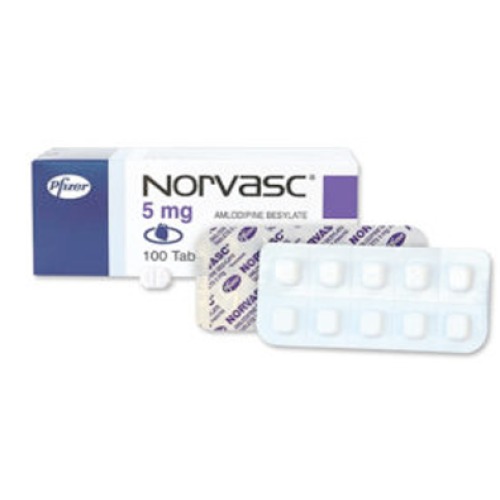Manufacturer: Pfizer
Pharmaceutical name: Amlodipine Besylate
Pack: 30 pills (5 mg)
Norvasc is a calcium channel blocker intended for managing high blood pressure or angina (chest pain). Controlling high blood pressure reduces the risk of strokes, heart attacks, and kidney issues. It has a prolonged effect and is primarily employed in managing hypertension. Additionally, it is utilized for treating and preventing attacks in chronic stable angina pectoris and Prinzmetal's angina (vasospastic angina pectoris).
Norvasc facilitates the relaxation of vascular smooth muscle, which increases the dilation of blood arteries. The exact mechanism of its action is not yet fully understood. The drug alleviates ischemia by dilating the arterioles in the peripheral vascular system, thus stabilizing myocardial function and reducing the consumption of energy and oxygen.
In both normal and ischemic areas, the dilated coronary artery enhances the supply of oxygen to the myocardium in angina patients and variably mitigates the effects of vasoconstrictors, particularly in smokers. Norvasc is fully metabolized into inactive metabolites, which are then eliminated through urine.
Norvasc is indicated for use in cases of hypertension, stable angina, and angina characterized by coronary vessel spasms. It may also be used alongside other cardiovascular conditions, but the treatment plan must be developed by a cardiologist.
Norvasc should be taken once daily with a glass of water. Food intake does not affect the medicinal properties of Amlodipine, so it can be administered either before or after meals. It is advisable to start with a minimal dose of Norvasc—5 mg daily. For hypertension and angina, the dosages are similar. If no side effects occur, the dosage may be increased to 10 mg per day after one week of treatment. The treatment should continue until there is a stable improvement in angina or hypertension symptoms. Elderly patients, as well as those with kidney and liver conditions, do not automatically require a dose reduction. The decision to lower the dosage should be made by the attending physician based on prior assessments.
The most frequently reported side effects of Norvasc during the first week of treatment include localized swelling in the lower legs and feet, tachycardia, dizziness, weakness, and stomach discomfort. In case of an overdose, there may be a sudden and significant drop in blood pressure and fainting, so it is advised not to exceed the daily limit of 10 mg.

